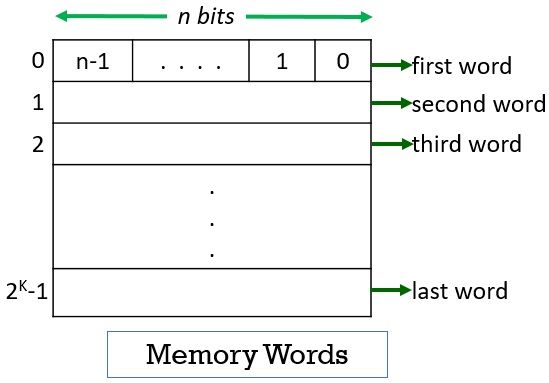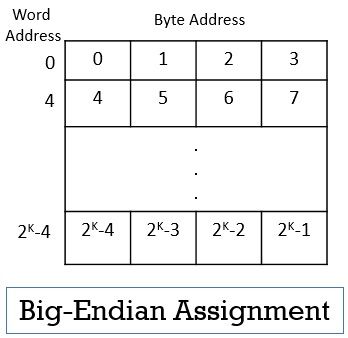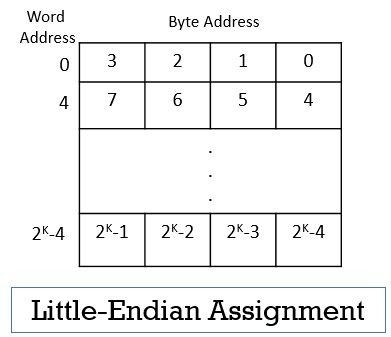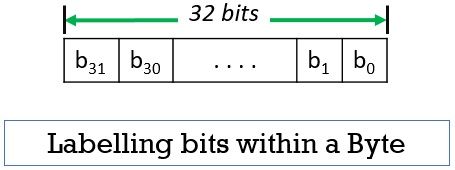Memory locations and addresses determine how the computer’s memory is organized so that the user can efficiently store or retrieve information from the computer. The computer’s memory is made of a silicon chip which has millions of storage cell, where each storage cell is capable to store a bit of information which value is either 0 or 1.
But the fact is, computer memory holds instructions and data. And a single bit is very small to hold this information so bits are rarely used individually. As a solution to this, the bits are grouped in fixed sizes of n bits. The memory of the computer is organized in such a way that the group of these n bits can be stored and retrieved easily by the computer in a single operation.
The group of n bit is termed as word where n is termed as the word length. The word length of the computer has evolved from 8, 16, 24, 32 to 64 bits. General-purpose computers nowadays have 32 to 64 bits. The group of 8 bit is called a byte.

Now, whenever you want to store any instruction or data may it be of a byte or a word you have to access a memory location. To access the memory location either you must know the memory location by its unique name or it is required to provide a unique address to each memory location.
The memory locations are addressed from 0 to 2K-1 i.e. a memory has 2K addressable locations. And thus the address space of the computer has 2K addresses. Let us try some suitable values for K.
210 = 1024 = 1K (Kilobyte)
220 = 1,048,576 = 1M (Megabyte)
230 = 1073741824 = 1G (Gigabyte)
240 = 1.0995116e+12 = 1T (Terabyte)
Byte Addressability
Till now we have gone through three information storing quantities bit, byte and word. We have seen above that 8 bits together form a byte and this is the fix for every memory. But the word length varies from memory to memory and it ranges from 16 to 64 bit.
Well, it is impossible to allot a unique address to each bit in memory. As a solution, most modern computers assign successive addresses to successive byte locations in memory. This assignment of addresses to individual byte locations is termed byte addressability and memory is referred to as byte-addressable memory.
If we assign an address to individual byte locations in the memory like 0, 1, 2, 3…. .Now if the word length of the machine is 16 bit then the successive words are located at addresses 0, 2, 4, 6… where each word would have 2 bytes of information. Similarly, if we have a machine with a word length of 32 bit then the successive words are located at the addresses 0, 4, 8, 12… where each word would have 4 bytes of information and it could store or retrieve 4 bytes of instruction or data in a single and basic operation.
Big-Endian and Little-Endian Assignments in Byte Addresses
The big-endian and little-endian are two methods of assigning byte addresses across the words in the memory. In the big-endian assignment, the lower byte addresses are used for the leftmost bytes of the word. Observe the word 0 in the image below, the leftmost bytes of the word have lower byte addresses.

In the little-endian assignment, the lower byte addresses are used for the rightmost bytes of the word. Observe the word 0 in the image below the rightmost bytes of word 0 has lower byte addresses.

The leftmost bytes of the word are termed as most significant bytes and the rightmost bytes of the words are termed as least significant bytes.
Thus the big-endian and little-endian specify the ordering of bytes inside a word. Similarly, the bits must be labelled inside the byte or a word and the most common way of labelling bits in a byte or word is as shown in the figure below i.e. labelling the bits as b7, b6,…….,b1, b0 from left to write as we do in little-endian assignment.

Word Alignment
In a machine with word length 32-bit, the word boundaries occur at the bytes addresses 0, 4, 8… It is said that the word has aligned addresses if they begin with the byte address that is multiple of the number of bytes present in that word. For example, the word address 4 has four bytes in it with byte address 4, 5 and 6. The word address 4 starts with the byte address 4 which is multiple of the number of bytes in word 4.
In case if the word address begins with the arbitrary byte address the word is said to have unaligned addresses. But conventionally the words have aligned addresses as this lets the access of memory operand more efficiently.
So, this is all about the memory locations and how they are addressed to store and retrieve the instructions or data more efficiently. With memory addresses, it becomes easy to identify a specific memory location.

mark nelson says
Thanks for the information my you make another blog post about calculation of memory
Enrique says
An example of “unaligned addresses” could be useful, thanks.